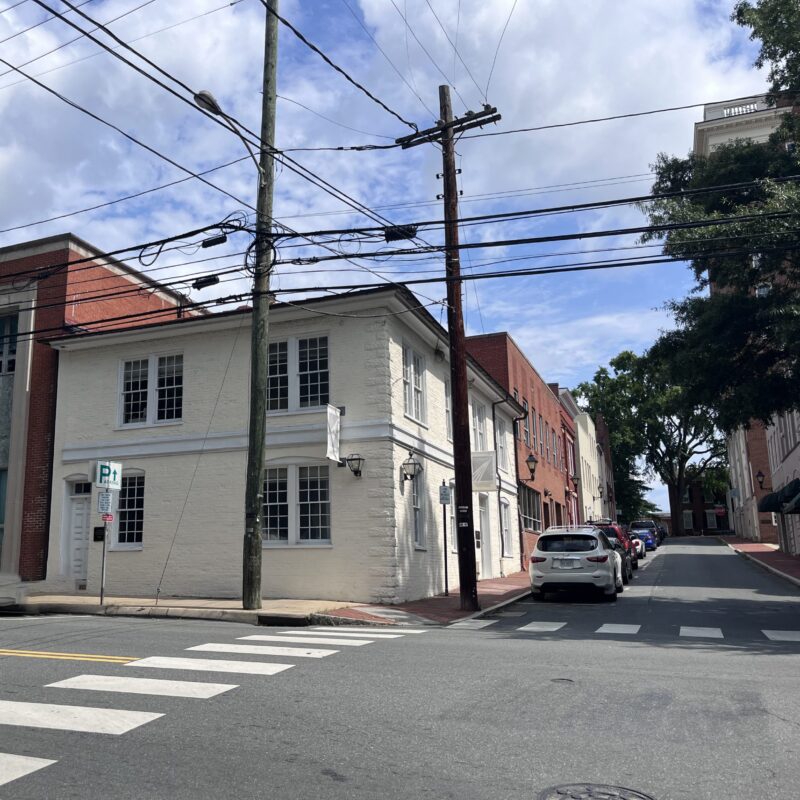Want to get deep into the question of who lived around here in TJ’s time? Start digging.
Archaeology related to the relationship between Thomas Jefferson and William Short may shed light on a relatively unknown class of people. Artifacts from tenant farmers were found at Morven, the farm donated by philanthropist John Kluge to the UVA Foundation in 2001.
|
Members of the Morven Project dig into a portion of the 1,334-acre “Indian Camp.” Since the December discovery of a letter from Thomas Jefferson to William Short, excavations of the site have turned up new information about white tenant farmers who once leased the land. |
“Nothing was known about that place, archaeologically,” says Steve Thompson of Rivanna Archaeological Services (RAS), who, along with UVA, Monticello and Washington & Lee University, conducted excavations at Morven that unearthed surprising realities of 18th and 19th century life.
A 1,334-acre tract of land named “Indian Camp,” in reference to Native Americans who may have lived in its vicinity, was bought by Jefferson on behalf of “his adopted son,” Short, in 1795.
In August 2008, members of the Morven Project and Stewart Gamage, director of Morven Programs, received an undated map of the tract of land. The map was then taken to Monticello, where Gamage and her team were told of the potential for unprecedented findings.
According to Gamage, “the next ah-ha moment” came in December 2009. While the ground was covered in snow and digging was out of the question, Thompson found a 19-page letter Jefferson sent to Short, “in which he lays out in really excruciating detail what this tenant farm proposition should look like, be like,” says Gamage. In it, Jefferson mentions tenant farmers by name and presents Short with a game plan: Get slaves to work the land.
Thompson says that because Short was an abolitionist, he did not want to have slaves on the property. “Instead, he directed Jefferson to maintain white tenant farmers,” he says.
The letter included another map with instructions.
“It goes into how it should be an obligation of everyone to restore the land, to add value to it,” she says. “It really is sort of an improvement policy, and it even has a draft lease that tells the tenant farmers, ‘Here is what you are going to grow, here is when you are going to grow it, here is how you are going to rotate it, here is when you are going to plant it.’ It leaves very little to chance.”
Research and digging uncovered details of Euro-American farmers in Central Virginia.
“To find somebody who was living on land that he didn’t own in the late 18th century and early 19th century is really exciting and very unusual,” says Alison Bell, professor of anthropology at Washington & Lee, who has brought her students to work the sites.
“It’s only been in the last decade or so that a few scholars have pointed out that we know much more about the extremes of the populations, the most impoverished and the most privileged, and we know very little about the middle,” says Bell.
“By looking at tenants and overseers and small farmers, not only are we going to fill the gap in knowledge but we will put the two ends of the spectrum in better perspective.”
RAS and its collaborators identified seven or eight archeological sites, of which two stood out and one showed particular promise. “The very artifacts that we got during our phase one survey indicated that it could well date to the 19th century,” says Thompson. The other one contained prehistoric artifacts. “The [site] along the stream of Indian Camp Creek produced some tiny little bits of prehistoric pottery”—Native American pottery that was only produced at the time of contact with the conquistadors. Much more, says Thompson, could be there.
Through a series of grants in the excess of $100,000, the work is proceeding. One of these grants, from the Library of Congress, will allow a graduate student to look into the relationship between Jefferson and Short.
“William Short is one of the most interesting people who lived in Albemarle County and nobody has ever heard of him,” says Gamage. Short is so unknown, and yet so involved in local affairs of the time, that 20,000 documents exist relating to him.
“To a certain extent, [Short] was the witness to an enormous amount of history. He is sort of the silent member of the quartet: Jefferson and Monticello, Madison and Montpelier, Monroe and Ashlawn,” and Short, says Gamage. “This is an untapped resource, that we are just starting to tap into.”
C-VILLE welcomes news tips from readers. Send them to news@c-ville.com.






